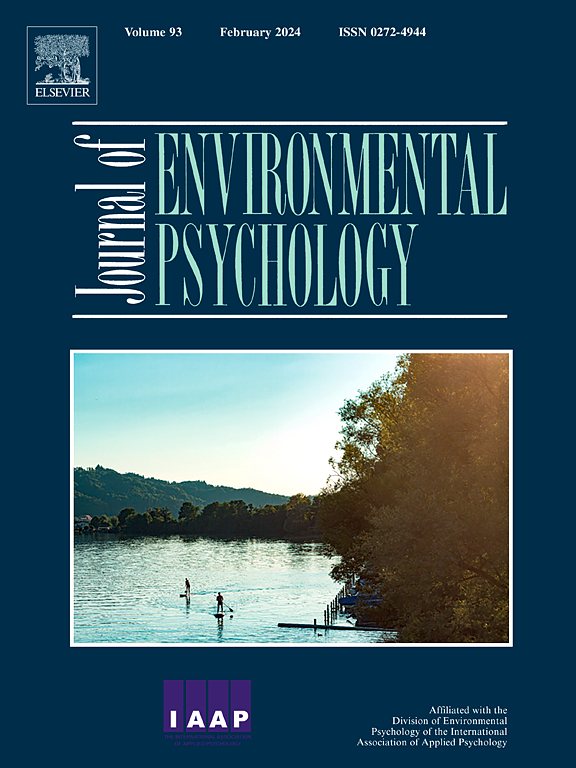目标框架理论的神经基础:评估规范性、享乐性和获得性环境信息的性质和说服力
IF 7
1区 心理学
Q1 ENVIRONMENTAL STUDIES
引用次数: 0
摘要
管理人员和决策者越来越多地采用传播运动来促进对环境负责的行为。通过各种各样的框架,这些运动可以鼓励公民采取更可持续的行动。目标框架理论认为,三个主要目标(规范性、获得性和享乐性)在嵌入信息时可以以不同的方式促进亲环境行为。本文提出了第一个控制这些目标激活的过程的实验研究,以及它们对促进亲环境行为(例如,回收,负责任的水消耗,减少电力使用和处理有毒产品)的信息的说服力的后续影响。该研究揭示了规范信息、增益信息和享乐信息处理的神经生物学机制。它还揭示了他们的相对说服力,正如理论上与说服力相关的大脑区域的活动所表明的那样。在这种背景下,神经成像(即功能磁共振成像)首次被用来表明,规范性信息激活了与心智化相关的大脑区域,享乐信息激活了与情感和奖励相关的大脑区域,获得信息激活了与个人利益和价值相关的大脑区域。在比较这些目标框架时,功能磁共振成像数据显示,规范性信息比获得性信息更能激活与亲社会背景(即道德认知)相关的大脑区域,并且两者都比享乐性信息更能引发激活。然而,自我报告的数据仅部分支持这种模式。在促进环境行为方面,享乐信息被认为是最没有说服力的,而收益框架信息被认为比规范信息更有说服力。这些结果对政府和管理者具有重要意义,他们应该设计吸引同伴驱动和基于社区的负责任行为的沟通方式。这种方法可能会导致对信息的价值和对社会规范的遵守进行更深入的评估。本文章由计算机程序翻译,如有差异,请以英文原文为准。
Neural bases of goal-frame theory: Assessing the nature and persuasion of normative, hedonic, and gain environmental messages
Managers and policymakers have increasingly adopted the use of communication campaigns to promote environmentally responsible behaviors. Through a wide variety of frames, these campaigns can encourage more sustainable actions from citizens. Goal-frame theory suggests that three primary goals (normative, gain, and hedonic) can promote pro-environmental behavior in different ways when embedded in messages. This paper presents the first controlled experimental study of the processes that govern the activation of these goals and their subsequent impact on the persuasiveness of messages promoting pro-environmental behaviors (e.g., recycling, responsible water consumption, reduced electricity use, and handling of toxic products). The study shows the neurobiological mechanisms underlying the processing of normative, gain, and hedonic messages. It also reveals their comparative persuasiveness, as indicated by activity in the brain regions theoretically linked to persuasion. For the first time in this context, neuroimaging (i.e., fMRI) is used to show that normative messages activate brain regions linked to mentalizing, hedonic messages activate brain regions linked to affect and reward, and gain messages activate brain regions linked to personal gain and value. When comparing these goal frames, fMRI data reveal that normative messages activate brain regions associated with persuasion in prosocial contexts (i.e., moral cognition) more strongly than gain messages, and both elicit greater activation than hedonic messages. However, self-reported data only partially support this pattern. Hedonic messages are perceived as the least persuasive in promoting environmental behaviors, and gain-framed messages are rated as significantly more persuasive than normative messages. These results have important implications for governments and managers, who should design communications that appeal to peer-driven and community-based responsible behaviors. Such an approach could lead to a deeper evaluation of the message's value and adherence to social norms.
求助全文
通过发布文献求助,成功后即可免费获取论文全文。
去求助
来源期刊

Journal of Environmental Psychology
Multiple-
CiteScore
10.60
自引率
8.70%
发文量
140
审稿时长
62 days
期刊介绍:
The Journal of Environmental Psychology is the premier journal in the field, serving individuals in a wide range of disciplines who have an interest in the scientific study of the transactions and interrelationships between people and their surroundings (including built, social, natural and virtual environments, the use and abuse of nature and natural resources, and sustainability-related behavior). The journal publishes internationally contributed empirical studies and reviews of research on these topics that advance new insights. As an important forum for the field, the journal publishes some of the most influential papers in the discipline that reflect the scientific development of environmental psychology. Contributions on theoretical, methodological, and practical aspects of all human-environment interactions are welcome, along with innovative or interdisciplinary approaches that have a psychological emphasis. Research areas include: •Psychological and behavioral aspects of people and nature •Cognitive mapping, spatial cognition and wayfinding •Ecological consequences of human actions •Theories of place, place attachment, and place identity •Environmental risks and hazards: perception, behavior, and management •Perception and evaluation of buildings and natural landscapes •Effects of physical and natural settings on human cognition and health •Theories of proenvironmental behavior, norms, attitudes, and personality •Psychology of sustainability and climate change •Psychological aspects of resource management and crises •Social use of space: crowding, privacy, territoriality, personal space •Design of, and experiences related to, the physical aspects of workplaces, schools, residences, public buildings and public space
 求助内容:
求助内容: 应助结果提醒方式:
应助结果提醒方式:


